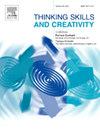创新的共鸣:以创新的系统模式编排古琴课程与创新教育模式的发展
IF 4.5
2区 教育学
Q1 Social Sciences
引用次数: 0
摘要
尽管传统音乐具有丰富的表现力和文化维度,但在学术研究和教育实践中,它往往被忽视。本研究解决了传统音乐学习实践中未被充分探索的创造力维度,填补了一个显著的研究空白,并有助于对高等音乐教育中创造力的更包容的理解。一个创新的课程是围绕古琴的学习和表演而设计的,古琴是传统音乐中一个小众但具有代表性的乐器。它也是世界著名的文化遗产,于2008年被联合国教科文组织列入《人类非物质文化遗产代表名录》。许多创造性学习的元素被系统地、无缝地融入到古琴课程中。更具体地说,本研究提出了一个由三个子系统组成的古琴学习动态框架。它吸引个体学习者,提供领域和创造力相关的知识,并为学生建立一个支持性的环境,鼓励自我表达和享受创造过程。本研究采用定性案例研究法,探讨学生对古琴创新课程的体验与理解。在为期16周的大学古琴课教学中,所有学生(N = 11)都参与了研究,为学习过程和教学设计提供了见解。结果表明,参与者的创造性思维和可转移技能得到了提高。参与者还报告说,这个项目有效地提高了他们的积极性、自我效能感、幸福感和创造力。这些都显示了传统音乐教育中创造力发展的巨大潜力。本文章由计算机程序翻译,如有差异,请以英文原文为准。
The resonances of innovation: Orchestrating a guqin course with the systems model of creativity and a creativity educational model development
Despite traditional music's rich expressive and cultural dimensions, it tends to be overlooked in discussions of creativity, both in academic research and educational practice. This study addresses underexplored dimensions of creativity within traditional music learning practices, filling a notable research gap and contributing to a more inclusive understanding of creativity in higher music education. An innovative course was designed around the learning and performance of the guqin, a niche yet representative instrument of traditional music. It is also a world-renowned cultural heritage inscribed on the Representative List of the Intangible Cultural Heritage of Humanity by the United Nations Educational, Scientific and Cultural Organization (UNESCO) in 2008. Numerous elements of creativity learning were systematically and seamlessly integrated into the guqin course. More specifically, this research proposes a dynamic framework comprising three subsystems for guqin learning. It engages individual learners, provides domain- and creativity-relevant knowledge, and establishes a supportive environment for students to encourage self-expression and enjoyment of the creation process. The study adopts a qualitative case study method to explore students' experiences and understanding of the innovative guqin course. Over a 16-week teaching period in a university guqin class, all students (N = 11) participated in the research, providing insights into the learning process and instructional design. The results indicated that the participants' creative thinking and transferable skills improved. The participants also reported that this programme effectively enhanced their motivation, self-efficacy, well-being, and creativity. These demonstrate the great potential for creativity development in traditional music education.
求助全文
通过发布文献求助,成功后即可免费获取论文全文。
去求助
来源期刊

Thinking Skills and Creativity
EDUCATION & EDUCATIONAL RESEARCH-
CiteScore
6.40
自引率
16.20%
发文量
172
审稿时长
76 days
期刊介绍:
Thinking Skills and Creativity is a new journal providing a peer-reviewed forum for communication and debate for the community of researchers interested in teaching for thinking and creativity. Papers may represent a variety of theoretical perspectives and methodological approaches and may relate to any age level in a diversity of settings: formal and informal, education and work-based.
 求助内容:
求助内容: 应助结果提醒方式:
应助结果提醒方式:


